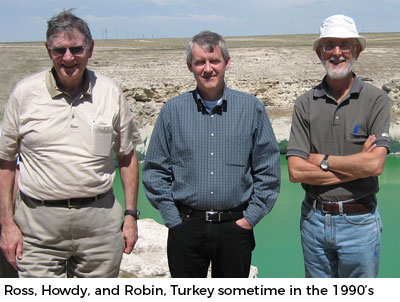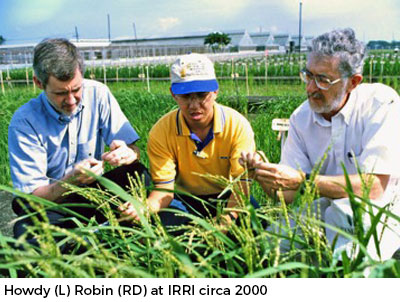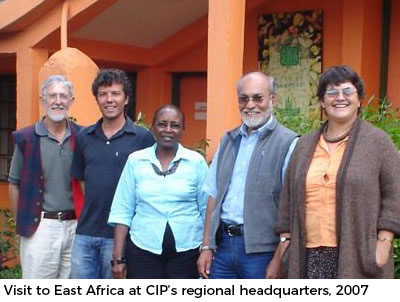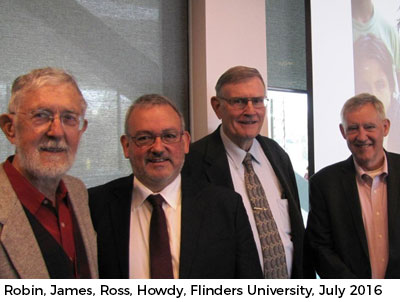Robin David Graham, my dear friend, mentor, and colleague, died on August 22 in Victor Harbor, Australia, close to his farm and near the University of Adelaide where he spent most of his career. He had celebrated his 80th birthday earlier this year.
In 1993, I traveled to nine CGIAR Centers to inquire what plant scientists thought about the feasibility of breeding for minerals and vitamins in food staples. I thought the potential economic returns to such an activity were substantial. The almost universal response during my conversations across the nine Centers was “No,” there will be a tradeoff between mineral and vitamin density and yield.
I had more or less accepted the conclusion that the plant breeding component (and so biofortification) would not work, when I met Robin Graham and his close personal friend and professional colleague, Ross Welch. Robin was a professor of plant nutrition at the University of Adelaide. Ross, trained as a soil scientist, was based at the USDA-ARS Plant, Soil, and Nutrition Laboratory (PSNL) at Cornell University.
Together they convinced me that the biofortification strategy was feasible. In fact, putting more zinc in seeds improved seedling vigor and vitality and could raise agricultural productivity. The three of us formed a close bond, and over the next 15 years or so, we worked together to advocate for investments in biofortification, and to begin the process of implementation. When any of us became discouraged, especially me, we encouraged each other to keep going.
Robin was soft-spoken and humble on the outside, always a gentleman. On the inside, he held fiercely to scientific truths as he saw them, and never wavered to compromise with a wider group of scientists. Along with Ross, he believed that iron bioavailability (iron from plants) in humans was much higher than was the conventional wisdom in the nutrition community at the time. The iron rice efficacy trial conducted in the Philippines provided evidence that he and Ross were correct.
 Robin was awarded the C.M. Donald Medal in 2008. Once every two years, the Australian Society of Agronomy awards the medal to an eminent Australian agriculturalist for a long and distinguished career. The award recognizes contributions in all areas of agronomy including scientific and field research, development and extension.
Robin was awarded the C.M. Donald Medal in 2008. Once every two years, the Australian Society of Agronomy awards the medal to an eminent Australian agriculturalist for a long and distinguished career. The award recognizes contributions in all areas of agronomy including scientific and field research, development and extension.
Robin was a great teacher. In simple terms, he taught me (an economist) several basic tenets of plant nutrition, and plant science more broadly. People who can explain to non-experts what they do in a clear way, really understand their stuff. I also noticed that he never dodged a difficult question.
In the early years before HarvestPlus started, Robin spent significant time at the International Rice Research Institute (IRRI). Under the CGIAR Micronutrients project, we had received a three-year grant (2000-2002) from the Asian Development Bank to begin development of iron rice. Robin brought in one of his former graduate students, James Stangoulis, to take the lead in coordinating activities between IRRI and collaborators in Bangladesh, Indonesia, the Philippines, and Vietnam.
How we organized cross-disciplinary and inter-institutional activities under the Asian Development Bank project for rice, became the prototype for how we coordinated the same types of activities for several crops under HarvestPlus. Robin was a guiding force in most aspects of the project. He was a stickler for detail and rigor. His intellectual input appeared throughout the Biofortification Challenge Program proposal, which was approved in 2002 and which would eventually become HarvestPlus.
 While in and out of Los Baños, where IRRI is located, and interacting with IRRI management, Robin wrote a proposal for establishment of a grain quality laboratory at IRRI. Donor funding ebbs and flows to CGIAR Centers. During a funding upturn, Robin’s proposal and advocacy were noted. A grain quality laboratory was re-established in 2003 which is still in operation.
While in and out of Los Baños, where IRRI is located, and interacting with IRRI management, Robin wrote a proposal for establishment of a grain quality laboratory at IRRI. Donor funding ebbs and flows to CGIAR Centers. During a funding upturn, Robin’s proposal and advocacy were noted. A grain quality laboratory was re-established in 2003 which is still in operation.
Thus, Robin’s legacy continues in my now hometown of Los Baños, and probably in other ways of which I am not aware.
Sometime during those early years, Robin and Ross introduced me to Ismail Cakmak, now at Sabanci University in Turkey. Ismail had discovered that putting zinc in fertilizers greatly improved wheat productivity in Turkey (making him something of a national hero), where soils are quite zinc deficient. And by the way, zinc fertilizers also increased seed zinc density. Robin, Ross, and I made at least two memorable trips to conferences in central Turkey which Ismail had organized. Now Ismail and I are collaborating on an effort to get the fertilizer industry to take on more fully its social responsibility to improve human nutrition.
One of Robin’s dreams was to conduct a fertilizer trial in a region whose soils were particularly bereft of trace minerals. In intervention villages, the range of trace minerals would be restored to soils. Over time, the hypothesis was that improvements in agricultural productivity could be recorded, as well as an increase in the mineral and vitamin content of crops. Both these outcomes would then combine to lead to improvements in human nutrition. It is a long-term, expensive study. It has never been funded. Robin made one trip to Nairobi to make a pitch to the person in charge of fertilizers at the Rockefeller Foundation office, a young economist who had graduated from Purdue University, Akin Adesina. He and Robin met again at the Second Global Conference on Biofortification held in Kigali in 2014. Akin, then the Nigeria Minister of Agriculture, graciously had travelled to Rwanda to give a keynote speech.
 Under HarvestPlus during Phase 1 (2003-2008), Robin and Ross headed a research component, shared between PSNL and the University of Adelaide, which we called “Breeding Objectives.” Essentially it focused on compounds which could impact on bioavailabilty, either positively or negatively. For example, resistant starches might improve gut health, and so increase micronutrient status for a range of minerals and vitamins, and lead to other beneficial health outcomes. Data were developed to investigate a number of hypotheses. Various in vitro and animal models were tested, used, improved. I found the research imaginative and prescient. In the end, the research was too “upstream,” too speculative for donors to want to continue to fund in the context of HarvestPlus.
Under HarvestPlus during Phase 1 (2003-2008), Robin and Ross headed a research component, shared between PSNL and the University of Adelaide, which we called “Breeding Objectives.” Essentially it focused on compounds which could impact on bioavailabilty, either positively or negatively. For example, resistant starches might improve gut health, and so increase micronutrient status for a range of minerals and vitamins, and lead to other beneficial health outcomes. Data were developed to investigate a number of hypotheses. Various in vitro and animal models were tested, used, improved. I found the research imaginative and prescient. In the end, the research was too “upstream,” too speculative for donors to want to continue to fund in the context of HarvestPlus.
The mainstreaming of fertilizer strategies into HarvestPlus activities also was rejected both by donors and the HarvestPlus Program Advisory Committee. The advice was: Don’t spread yourself too thinly; focus on the plant breeding strategy and deliver.
The involvement of Robin and Ross in HarvestPlus greatly diminished after 2008. Robin and Ross still helped HarvestPlus and biofortification in various capacities, such as giving presentations at conferences. They continued their own research and published on micronutrients at their respective institutions. The three of us got together most years in China at the HarvestPlus China meetings which were first held annually, then later once every two years. We had been appointed to the HarvestPlus China Advisory Committee.
Ross and I last saw Robin in July 2016. Ross and I flew to Canberra (a fundraising trip) together from the HarvestPlus China meeting. We knew it might the last time that Robin recognized us. His health was failing. Robin was there in Canberra with James and other collaborators (Graham Lyons of the University of Adelaide; Brian Hilton of World Vision; Alex Johnson of Melbourne University). It was quite a whirlwind in terms of media opportunities (Cathy Reade of the Crawford Fund did a fabulous job setting these up) as it had been announced that I would be awarded the World Food Prize in October (it takes a community to win the World Food Prize). We then proceeded to Adelaide.
 I visited Robin on his farm on three occasions. On trips to Australia, usually for fundraising in Canberra, I would make a side trip to Adelaide to visit Robin, James, and Graham, check-in on the research, and give an update presentation or two on HarvestPlus. The then-IFPRI Board Chair, Kym Anderson (Kym and I were together in graduate school) was also by then back at the University of Adelaide.
I visited Robin on his farm on three occasions. On trips to Australia, usually for fundraising in Canberra, I would make a side trip to Adelaide to visit Robin, James, and Graham, check-in on the research, and give an update presentation or two on HarvestPlus. The then-IFPRI Board Chair, Kym Anderson (Kym and I were together in graduate school) was also by then back at the University of Adelaide.
On that last trip, Ross and I spent two quiet days and nights on Robin’s farm, walking around, enjoying the surroundings and wine, and reminiscing. That was four years ago.
We all owe such a debt to Robin. I was so fortunate to have had him as my friend.
Howdy Bouis is Founding Director of HarvestPlus and Emeritus Fellow at IFPRI
